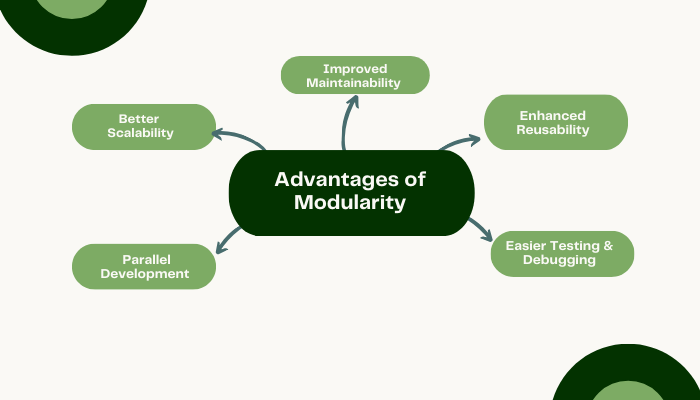Modularity is a fundamental concept in software engineering that enhances the scalability, maintainability, and reusability of code. It involves breaking down a complex system into smaller, independent, and interchangeable modules. Each module performs a specific function and can be developed, tested, and maintained separately while contributing to the overall system.
In this blog, we will explore the importance of modularity in software engineering, its advantages, best practices, and real-world applications.
What is Modularity in Software Engineering?
Modularity refers to the design principle of decomposing a software system into distinct, self-contained units called modules. Each module has a well-defined purpose and interacts with other modules through interfaces. This approach follows the Separation of Concerns (SoC) principle, which ensures that each module handles a specific functionality.
For example, in a web application, different modules can be:
User Authentication Module – Handles login, registration, and authentication.
Database Module – Manages data storage and retrieval.
Payment Module – Handles transactions and payment processing.
Each of these modules can be developed independently and integrated into the system seamlessly.
Advantages of Modularity in Software Engineering

1. Improved Maintainability
One of the major advantages of modularity is that it significantly improves maintainability. Since each module is self-contained and performs a specific function, developers can isolate and modify parts of the software without impacting the entire system. This isolation allows for easier debugging, patching, and updating. When an issue arises, developers can quickly pinpoint the problematic module and resolve it without worrying about unforeseen side effects in other parts of the application. This clear separation of concerns enhances code readability and makes long-term software maintenance more sustainable and efficient.
2. Enhanced Reusability
Modularity encourages code reusability, which reduces development time and effort. A well-designed module can be reused across multiple projects or in different components of the same application. For example, a user authentication module or a payment gateway integration developed once can be seamlessly reused wherever needed without writing the logic from scratch. This not only saves time but also ensures consistency and reliability across applications. Reusable modules also contribute to the creation of software libraries and frameworks that promote faster and standardized development.
3. Better Scalability
A modular system architecture allows for seamless scaling of software applications. As business needs grow, new features or services can be added in the form of separate modules without disturbing the existing structure. Developers can integrate new functionalities independently, which reduces the risk of introducing bugs into stable parts of the system. This makes the software highly adaptable to changes and future expansion. Scalability becomes more manageable and cost-effective when each new component can be developed and deployed independently.
4. Parallel Development
In modular software development, different teams or individual developers can work on separate modules simultaneously. This parallel development approach significantly speeds up the software development lifecycle. Teams can focus on their specific modules, follow best practices, and meet deadlines independently without being bottlenecked by other teams’ progress. This kind of collaborative environment enhances productivity, promotes specialization, and ensures that large-scale software systems are developed efficiently.
5. Easier Testing and Debugging
Testing becomes more effective and streamlined in a modular system. Since modules are loosely coupled and function independently, unit testing can be performed on each module in isolation. This makes it easier to detect bugs, verify functionality, and ensure each module behaves as expected. When a bug is detected, developers can quickly narrow down the scope of the issue and fix it without affecting unrelated modules. This modular testing approach reduces debugging time and increases overall software reliability. These advantages collectively highlight the significance of Modularity in Software Engineering.
Best Practices for Implementing Modularity
To effectively implement modularity in software development, follow these best practices:
1. Define Clear Interfaces
Each module should expose a well-defined interface for communication with other modules. A clear and consistent interface reduces coupling and ensures that modules can interact without relying on each other’s internal workings. By adhering to interface-based design, developers can update the internal implementation of a module without breaking other parts of the system. This approach encourages cleaner integration and allows teams to work on modules independently, boosting overall project flexibility and maintainability.
2. Follow the Single Responsibility Principle (SRP)
The Single Responsibility Principle is a key software design rule stating that a module should focus on a single functionality or concern. When each module is designed to do one thing well, it becomes easier to test, maintain, and debug. Additionally, such focused modules are more likely to be reused across different parts of the application or even in other projects. Adhering to SRP ensures that changes required for one responsibility don’t unintentionally affect others, thereby maintaining a cleaner and more stable codebase.
3. Use Encapsulation
Encapsulation is the practice of hiding the internal details of a module and exposing only what is necessary through public interfaces. This ensures that the inner workings of a module remain private and protected from external access, reducing the risk of accidental interference or misuse. Encapsulation improves security, makes modules easier to understand, and ensures that changes in implementation do not impact other modules that depend on it. This abstraction also enhances code readability and promotes a modular, object-oriented approach.
4. Keep Modules Independent
Strive to make each module as independent as possible by reducing dependencies on other modules. Independence allows developers to modify or upgrade one module without requiring extensive changes elsewhere. This also supports better unit testing and facilitates parallel development, as teams can work on individual modules in isolation. High module independence leads to a more resilient system where the impact of changes or failures is minimized, making the software easier to maintain and scale.
5. Implement a Modular Architecture
Adopting a modular software architecture, such as Microservices, Layered Architecture, or Plugin-based Architecture, is crucial for managing complex and large-scale applications. These patterns allow software to be split into distinct, manageable parts that interact through standardized interfaces. A well-structured architecture provides flexibility, scalability, and ease of integration for new features. Whether building a distributed application or a monolithic system, choosing the right modular design approach ensures long-term success and aligns with the principles of Modularity in Software Engineering.
Real-World Applications of Modularity
1. Microservices Architecture
Modern software applications often adopt a Microservices Architecture, where each service functions as an independent module responsible for a specific business capability. Examples include modules for user authentication, order processing, payment gateways, and email notifications. These services communicate through lightweight APIs, making the entire system more flexible and scalable. Microservices also allow development teams to deploy, scale, and maintain each service separately, which accelerates the development lifecycle and enhances system resilience.
2. Object-Oriented Programming (OOP)
Object-Oriented Programming (OOP) inherently supports the concept of modularity through the use of classes and objects. In OOP languages such as Java, Python, and C++, developers create modular structures where each class encapsulates data (attributes) and behavior (methods) related to a specific functionality. This encapsulation and abstraction make it easier to maintain and reuse code across applications. These principles are fundamental to implementing Modularity in Software Engineering, as they promote clean separation of concerns, code organization, and reusability.
3. Modular Front End Development
Frontend development has seen significant modular advancements with the rise of frameworks like React, Angular, and Vue.js. These frameworks allow developers to build user interfaces using independent, reusable components. Each component encapsulates its HTML, CSS, and JavaScript logic, which can be reused across multiple parts of the application. This modular approach speeds up UI development, simplifies debugging, and ensures a more maintainable frontend architecture. It also enhances collaboration among developers working on different parts of the UI.
4. Software Plugins and Extensions
Many modern software applications, including web browsers (like Chrome or Firefox) and development tools (like Visual Studio Code or IntelliJ IDEA), support modularity through plugin systems. Plugins are external modules that extend or customize the functionality of the core software without altering its internal structure. This approach enables third-party developers to enhance software features without direct access to or modification of the main codebase. The plugin architecture is a practical and powerful example of modular software design that supports customization and extensibility.
Frequently Asked Questions?
Q1: What is modularity in software engineering?
A1: Modularity is the design principle of dividing a software system into smaller, independent, and reusable components called modules.
Q2: Why is modularity important in software development?
A2: It improves code reusability, maintainability, scalability, and debugging while reducing complexity.
Q3: What are the key characteristics of modularity?
A3: Key characteristics include high cohesion, low coupling, reusability, and well-defined interfaces.
Q4: What is cohesion in modularity?
A4: Cohesion refers to the degree to which the elements within a module are related and work together for a single purpose.
Q5: What are some examples of modular programming languages?
A5: Examples include Java, Python, C++, and C#, which support modular development through classes, functions, and packages.
Q6: How does modularity support software reuse?
A6: Well-designed modules can be reused across multiple projects, reducing development time and cost.
Conclusion
Modularity in software engineering is essential for building scalable, maintainable, and efficient software systems. By dividing a complex system into independent, reusable modules, developers can improve productivity, enhance code quality, and make future modifications easier. Whether designing a simple application or a large-scale enterprise system, adopting modular principles ensures long-term success.
I hope you understand the Understanding Modularity in Software Engineering. So don’t forget to share this post with friends and anyone preparing for the GATE, UGC NET exams, or studying at the university.
Would you like to explore specific modular design patterns or examples in a particular programming language? Let me know in the comments!



